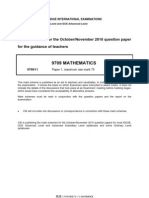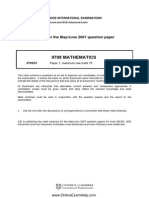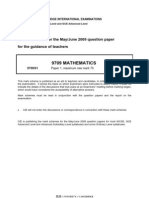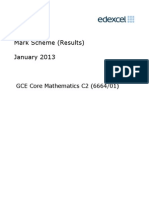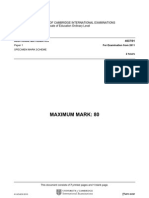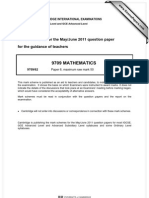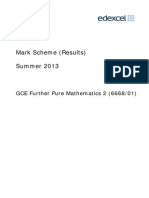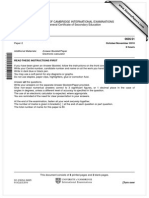0606 w10 Ms 11
0606 w10 Ms 11
Uploaded by
Khoo Kian ChaiCopyright:
Available Formats
0606 w10 Ms 11
0606 w10 Ms 11
Uploaded by
Khoo Kian ChaiOriginal Title
Copyright
Available Formats
Share this document
Did you find this document useful?
Is this content inappropriate?
Copyright:
Available Formats
0606 w10 Ms 11
0606 w10 Ms 11
Uploaded by
Khoo Kian ChaiCopyright:
Available Formats
w
w
ap
eP
e
tr
.X
UNIVERSITY OF CAMBRIDGE INTERNATIONAL EXAMINATIONS
for the guidance of teachers
0606 ADDITIONAL MATHEMATICS
0606/11
Paper 1, maximum raw mark 80
This mark scheme is published as an aid to teachers and candidates, to indicate the requirements of
the examination. It shows the basis on which Examiners were instructed to award marks. It does not
indicate the details of the discussions that took place at an Examiners meeting before marking began,
which would have considered the acceptability of alternative answers.
Mark schemes must be read in conjunction with the question papers and the report on the
examination.
CIE will not enter into discussions or correspondence in connection with these mark schemes.
CIE is publishing the mark schemes for the October/November 2010 question papers for most IGCSE,
GCE Advanced Level and Advanced Subsidiary Level syllabuses and some Ordinary Level
syllabuses.
om
.c
MARK SCHEME for the October/November 2010 question paper
s
er
International General Certificate of Secondary Education
Page 2
Mark Scheme: Teachers version
IGCSE October/November 2010
Syllabus
0606
Paper
11
Mark Scheme Notes
Marks are of the following three types:
M
Method mark, awarded for a valid method applied to the problem. Method marks are
not lost for numerical errors, algebraic slips or errors in units. However, it is not
usually sufficient for a candidate just to indicate an intention of using some method or
just to quote a formula; the formula or idea must be applied to the specific problem in
hand, e.g. by substituting the relevant quantities into the formula. Correct application
of a formula without the formula being quoted obviously earns the M mark and in some
cases an M mark can be implied from a correct answer.
Accuracy mark, awarded for a correct answer or intermediate step correctly obtained.
Accuracy marks cannot be given unless the associated method mark is earned (or
implied).
Accuracy mark for a correct result or statement independent of method marks.
When a part of a question has two or more method steps, the M marks are generally
independent unless the scheme specifically says otherwise; and similarly when there are
several B marks allocated. The notation DM or DB (or dep*) is used to indicate that a
particular M or B mark is dependent on an earlier M or B (asterisked) mark in the scheme.
When two or more steps are run together by the candidate, the earlier marks are implied and
full credit is given.
The symbol implies that the A or B mark indicated is allowed for work correctly following
on from previously incorrect results. Otherwise, A or B marks are given for correct work
only. A and B marks are not given for fortuitously correct answers or results obtained from
incorrect working.
Note:
B2 or A2 means that the candidate can earn 2 or 0.
B2, 1, 0 means that the candidate can earn anything from 0 to 2.
UCLES 2010
Page 3
Mark Scheme: Teachers version
IGCSE October/November 2010
Syllabus
0606
Paper
11
The following abbreviations may be used in a mark scheme or used on the scripts:
AG
Answer Given on the question paper (so extra checking is needed to ensure that
the detailed working leading to the result is valid)
BOD
Benefit of Doubt (allowed when the validity of a solution may not be absolutely
clear)
CAO
Correct Answer Only (emphasising that no follow through from a previous error
is allowed)
ISW
Ignore Subsequent Working
MR
Misread
PA
Premature Approximation (resulting in basically correct work that is insufficiently
accurate)
SOS
See Other Solution (the candidate makes a better attempt at the same question)
Penalties
MR 1
A penalty of MR 1 is deducted from A or B marks when the data of a question or
part question are genuinely misread and the object and difficulty of the question
remain unaltered. In this case all A and B marks then become follow through
marks. MR is not applied when the candidate misreads his own figures this is
regarded as an error in accuracy.
OW 1,2 This is deducted from A or B marks when essential working is omitted.
PA 1
This is deducted from A or B marks in the case of premature approximation.
S 1
Occasionally used for persistent slackness usually discussed at a meeting.
EX 1
Applied to A or B marks when extra solutions are offered to a particular equation.
Again, this is usually discussed at the meeting.
UCLES 2010
Page 4
(i)
Mark Scheme: Teachers version
IGCSE October/November 2010
a = 12, b = 4
Syllabus
0606
Paper
11
B1, B1
B1 for each
[2]
(ii) 4
Follow through on their y value
B1
[1]
(i)
Graphs
B1 for one correct curve
B1 for a second correct curve consistent
with the first curve
B1
B1
[2]
(ii) 3
Follow through on number of clear points
of intersection
B1
[1]
cos x(1 + sin x ) + cos x(1 sin x )
1 sin 2 x
2 cos x
cos 2 x
2 sec x
M1 for attempt to get in terms of a single
fraction
DM1 simplifying numerator
M1 simplifying denominator
M1
DM1
M1
A1
[4]
1
seen
2
(x + 1) 2 x 2 13x 7
x = 1 or 7 or
Either
(
)
(x 7 )(2 x + 3x + 1)
(2 x + 1)(x 6 x 7 )
2
or
or
leading to
(x + 1)(x 7 )(2 x + 1)
M1
M1 for attempt to find a root
DM1
DM1 for attempt to obtain quadratic
factor
A1 correct quadratic factor
A1
DM1 attempt to factorise quadratic factor
DM1,
A1
[5]
(i)
(ii)
a = +
4
, a=
3
3
dy
= 2 x cos x + 2 sin x
dx
dy
1
at P,
= 2 , grad of normal =
2
dx
4
1
normal: y
= x
3
2
2
19
x
2y =
6
Must be in terms of
B1
[1]
M1, A1
M1 for attempt to differentiate a product
M1
M1 for m1m2 = 1, must have used
differentiation
M1, A1
M1 for attempt at a normal equation, must
have used differentiation, allow
unsimplified
[5]
UCLES 2010
Page 5
(i)
Mark Scheme: Teachers version
IGCSE October/November 2010
64 960 x + 6000 x 2
(ii) 1 (their x term) +
10
(their 64)
2
Syllabus
0606
6
B1, B1, B1 for each correct term, allow 2
B1
[3]
M1
M1 for 2 terms
B1
A1
960 + 320
= 640
Paper
11
B1 for
10
or 5
2
[3]
7
(a) (i) x = 30, 150
(ii) x 30 = 120, 240
x = 150, 270
A B = {30, 150, 270}
B1, B1
B1 for each
[2]
B1 for x = 150, 270 only
Follow through on their A and B
B1
B1
[2]
(b) cos 3 x = 1 or tan 3 x = 0
3x = 0, 180, 360, 540
x = 0, 60, 120, 180
n(C) = 4
M1
M1 for dealing with sec and 3x
A1
B1
A1 for all solutions correct
Follow through on their number of
solutions
[3]
(i) and (ii) Gradient = 0.5
Use of ratios or ln y = 0.5 ln x + c
ln y = 6.8
ln y = b ln x + ln A
A = e ( their 6.8 )
A = 898, b = 0.5
(i)
A = x2 ,
dA
= 2x
dx
(ii) When x = 5,
dx 0.003
=
dt
10
dA
= 10
dx
= 0.0003
M1
M1
A1
B1
M1
A1, A1
[7]
M1 for attempt at gradient
M1 for attempt at y intercept
A1 for ln y = 6.8
B1 for ln y = b ln x + ln A
M1 for use of e
A1 for A and A1 for b
B1
[1]
B1
Follow through on their
M1
M1 for 0.003 their 10
A1
[3]
(iii) V = 4x 3 ,
dV
= 12 x 2
dx
dV
= 12 x 2 0.0003
dt
= 0.09
B1, B1
M1
A1
[4]
UCLES 2010
B1 for each
dA
dx
Page 6
10 (i)
Mark Scheme: Teachers version
IGCSE October/November 2010
4
, PA = 4 3
=
6 PA
4
PB =
+ 4 , PB = 12
sin
6
allow equivalent methods
tan
Syllabus
0606
B1
B1 for PA (answer given)
B1
Paper
11
B1 for PB (answer given)
[2]
1 2
12
2
3
1
Area of kite = 2 4 3 4
2
(ii) Sector area =
B1
M1, A1
Shaded area = 47.7
B1 sector area, ft on their PB
M1 for attempt to find area of kite or
appropriate triangle
A1
[4]
(iii) P = 12 + 2 12 4 3 + 2(4 )
3
B1, B1, B1 for each of the 3 terms
B1
B1 for final answer
B1
[4]
= 30.7
11 (i)
2(1 + x ) 2 (+ c )
dy
=
(ii)
dx
(iii)
M1, A1 M1 for (1 + x )2 , A1 for 2
[2]
1
1
(1 + x ) 2
2
1+ x
2 1 + x 2x
M1
A2, 1, 0
A1
( 1+ x) ( 1+ x)
x
= 4 1+ x
3
( 1+ x)
0
dx =
A1 all correct
( 1+ x)
M1 attempt at differentiation
1 each error
( 1 + x ) dx
[4]
2x
M1
M1 for idea of using (ii) in reverse
2x
(+ c )
1+ x
A1
A1 all correct
dx = (8 3) (4), = 1
M1, A1
M1 for attempt evaluation
1+ x
[4]
UCLES 2010
Page 7
Mark Scheme: Teachers version
IGCSE October/November 2010
12 EITHER
4 x3
9 x(+ c )
(i) y =
3
when x = 3, y = 1, so c = 8
M1, A1
M1
1
6
12 OR
(i) 50 = A + B
dy
= 2 Ae 2 x Be x
dx
20 = 2A B
leads to A = 10 and B = 40
dy
= 20e 2 x 40e x , 20e 2 x = 40e x
dx
M1 for attempt to find midpoint
M1
M1 for attempt to find grad of perp
M1, A1 M1 must be working with perp
[4]
B1
M1
A1
DM1
A1
M1 for attempt to differentiate
A1 all correct
DM1 for attempt to solve equations.
[5]
M1
M1
M1 for equating to zero and attempt at
solution
M1 for dealing with exponentials
M1 for attempt to obtain x
A1
A1 for both
M1
3x
e =2
1
x = ln 2 or 0.231
3
y = 47.6
dy
=0
dx
A1, A1
A1 for each pair
[3]
(iii) Midpoint AB: (0, 8)
(ii)
M1 for attempt to integrate
M1 for attempt to solve
M1
Points (1.5, 17), (1.5, 1)
Equation: x 6y = 48
Paper
11
M1, A1 M1 for attempt to find c
[4]
(ii) 4x2 9 = 0, leads to x = 1.5
Gradient of AB = 6, perp grad =
Syllabus
0606
[4]
(iii)
d2 y
= 40e 2 x + 40e x
2
dx
M1
Always +ve, so min
A1
M1 for attempt at second derivative or
other valid method
A1 for a correct conclusion
[2]
UCLES 2010
You might also like
- HESI A2 Math Practice Tests: HESI A2 Nursing Entrance Exam Math Study GuideFrom EverandHESI A2 Math Practice Tests: HESI A2 Nursing Entrance Exam Math Study GuideNo ratings yet
- 9709 Mathematics: MARK SCHEME For The May/June 2011 Question Paper For The Guidance of TeachersDocument6 pages9709 Mathematics: MARK SCHEME For The May/June 2011 Question Paper For The Guidance of TeachersJia SyuenNo ratings yet
- Data Interpretation Guide For All Competitive and Admission ExamsFrom EverandData Interpretation Guide For All Competitive and Admission ExamsRating: 2.5 out of 5 stars2.5/5 (6)
- 1591Document30 pages1591Khoo Kian ChaiNo ratings yet
- Principles of Teaching by Francisco ZuluetaDocument5 pagesPrinciples of Teaching by Francisco ZuluetaJudd Vander Rondares100% (1)
- 0606 w10 Ms 12Document7 pages0606 w10 Ms 12Khoo Kian ChaiNo ratings yet
- 4037 w09 Ms 1Document7 pages4037 w09 Ms 1mstudy123456No ratings yet
- 4037 s10 Ms 12Document7 pages4037 s10 Ms 12mstudy123456No ratings yet
- 4037 w11 Ms 13Document8 pages4037 w11 Ms 13mstudy123456No ratings yet
- 9709 w10 Ms 11Document7 pages9709 w10 Ms 11Joseph Dj-mo KellyNo ratings yet
- 9709 s07 Ms 1 PDFDocument6 pages9709 s07 Ms 1 PDFtess_15No ratings yet
- 9709 s05 Ms 1Document9 pages9709 s05 Ms 1Halıl UskuriNo ratings yet
- 4037 s05 Ms 2Document9 pages4037 s05 Ms 2Sherlock Wesley ConanNo ratings yet
- 4037 s07 Ms 1Document8 pages4037 s07 Ms 1mstudy123456No ratings yet
- 9709 s11 Ms 12Document7 pages9709 s11 Ms 12Diksha KoossoolNo ratings yet
- 0606 w10 Ms 22Document7 pages0606 w10 Ms 22Khoo Kian ChaiNo ratings yet
- 9709 s10 - ms31Document118 pages9709 s10 - ms31ShoummaShamsNo ratings yet
- A Level Maths November 2012 Mark Scheme 12Document7 pagesA Level Maths November 2012 Mark Scheme 12Kelvin MuzaNo ratings yet
- 9709 s09 Ms 1Document6 pages9709 s09 Ms 1Thapa GorkhaNo ratings yet
- C1 January 2012 Mark SchemeDocument17 pagesC1 January 2012 Mark SchemegerikaalhuNo ratings yet
- 4037 w12 Ms 22 PDFDocument7 pages4037 w12 Ms 22 PDFAsha D'saNo ratings yet
- 9709 w03 MsDocument33 pages9709 w03 Msmichael hengNo ratings yet
- 9709 s05 Ms 1 PDFDocument9 pages9709 s05 Ms 1 PDFtess_15No ratings yet
- 9709 Mathematics: MARK SCHEME For The May/June 2008 Question PaperDocument7 pages9709 Mathematics: MARK SCHEME For The May/June 2008 Question PaperYaviish CullenNo ratings yet
- Second C1 SolutionsDocument22 pagesSecond C1 SolutionsyohoNo ratings yet
- C3 June 2014 Mark SchemeDocument30 pagesC3 June 2014 Mark SchemeAnonymous 9u1EUbB0A7No ratings yet
- Mark Scheme (Results) January 2013: GCE Core Mathematics C2 (6664/01)Document15 pagesMark Scheme (Results) January 2013: GCE Core Mathematics C2 (6664/01)James TaylorNo ratings yet
- Maximum Mark: 80: University of Cambridge International Examinations General Certificate of Education Ordinary LevelDocument8 pagesMaximum Mark: 80: University of Cambridge International Examinations General Certificate of Education Ordinary LevelSutoyo SudNo ratings yet
- Mark Scheme (Results) Summer 2013: GCE Core Mathematics 1 (6663/01R)Document18 pagesMark Scheme (Results) Summer 2013: GCE Core Mathematics 1 (6663/01R)fdsfdsakjlrikjldNo ratings yet
- June 2022 MSDocument33 pagesJune 2022 MSCharbel El habrNo ratings yet
- Math 9709 - s11 - Ms - 62Document6 pagesMath 9709 - s11 - Ms - 62purni.mnath4574No ratings yet
- 9709 w15 Ms 12 PDFDocument7 pages9709 w15 Ms 12 PDFyuke kristinaNo ratings yet
- 9231 s14 Ms 11Document10 pages9231 s14 Ms 11Cheah Jun SiangNo ratings yet
- 4PM0 02 MSC 20120307Document12 pages4PM0 02 MSC 20120307Lalith77No ratings yet
- Mark Scheme (Results) Summer 2013: GCE Further Pure Mathematics 2 (6668/01)Document25 pagesMark Scheme (Results) Summer 2013: GCE Further Pure Mathematics 2 (6668/01)Dency Dela CruzNo ratings yet
- Mark Scheme (Results) January 2014: Pearson Edexcel International GCSE Further Pure Mathematics (4PM0/01) Paper 1Document24 pagesMark Scheme (Results) January 2014: Pearson Edexcel International GCSE Further Pure Mathematics (4PM0/01) Paper 1Lalith77No ratings yet
- Mark Scheme (Results) Summer 2013: GCE Core Mathematics 1 (6663/01)Document18 pagesMark Scheme (Results) Summer 2013: GCE Core Mathematics 1 (6663/01)AdrianaBeckNo ratings yet
- 0606 s13 Ms 22Document9 pages0606 s13 Ms 22Fred HarrisonNo ratings yet
- January 2021 MS PDFDocument24 pagesJanuary 2021 MS PDFAdv LaketNo ratings yet
- 9709 s13 Ms 73 PDFDocument6 pages9709 s13 Ms 73 PDFDiksha KoossoolNo ratings yet
- Mark Scheme Syllabus Mathematics - June 2003 9709Document42 pagesMark Scheme Syllabus Mathematics - June 2003 9709Iqra JawedNo ratings yet
- C12 January 2014 (IAL) Mark Scheme PDFDocument24 pagesC12 January 2014 (IAL) Mark Scheme PDFRehanNo ratings yet
- 9709 Oct Nov 2011 All Mark SchemesDocument130 pages9709 Oct Nov 2011 All Mark SchemesRaisa Binte Huda100% (1)
- 9709 Mathematics: MARK SCHEME For The May/June 2010 Question Paper For The Guidance of TeachersDocument6 pages9709 Mathematics: MARK SCHEME For The May/June 2010 Question Paper For The Guidance of TeachersDiksha KoossoolNo ratings yet
- June 2010 (v2) MS - P1Document6 pagesJune 2010 (v2) MS - P1mahtabsilvercraftNo ratings yet
- 9709 w12 Ms 33Document7 pages9709 w12 Ms 33Nicholas TehNo ratings yet
- 4037 s12 Ms 21Document8 pages4037 s12 Ms 21mstudy123456No ratings yet
- Mark Scheme (Results) June 2013: GCE Core Mathematics 4 (6666/01)Document28 pagesMark Scheme (Results) June 2013: GCE Core Mathematics 4 (6666/01)Abdulrahman JijawiNo ratings yet
- 9709 Mathematics: MARK SCHEME For The May/June 2009 Question Paper For The Guidance of TeachersDocument8 pages9709 Mathematics: MARK SCHEME For The May/June 2009 Question Paper For The Guidance of TeachersSeleine ChongNo ratings yet
- 9709 w11 Ms 32Document7 pages9709 w11 Ms 32Helen B. EvansNo ratings yet
- 4pm1 01 Rms 20230302Document32 pages4pm1 01 Rms 20230302Manjur AhmadNo ratings yet
- 9709 s15 Ms 12Document7 pages9709 s15 Ms 12Andrian M YusufNo ratings yet
- Real Estate Math Express: Rapid Review and Practice with Essential License Exam CalculationsFrom EverandReal Estate Math Express: Rapid Review and Practice with Essential License Exam CalculationsNo ratings yet
- Student's Solutions Manual and Supplementary Materials for Econometric Analysis of Cross Section and Panel Data, second editionFrom EverandStudent's Solutions Manual and Supplementary Materials for Econometric Analysis of Cross Section and Panel Data, second editionNo ratings yet
- Let's Practise: Maths Workbook Coursebook 7From EverandLet's Practise: Maths Workbook Coursebook 7No ratings yet
- Skema Trial k2 MRSMDocument26 pagesSkema Trial k2 MRSMKhoo Kian ChaiNo ratings yet
- Confidential Examination Results Information: Shengkh9 Nvtbx4EdDocument1 pageConfidential Examination Results Information: Shengkh9 Nvtbx4EdKhoo Kian ChaiNo ratings yet
- 0606 w10 Ms 22Document7 pages0606 w10 Ms 22Khoo Kian ChaiNo ratings yet
- 0606 w10 Ms 22Document7 pages0606 w10 Ms 22Khoo Kian ChaiNo ratings yet
- Paper2 Set2Document19 pagesPaper2 Set2Khoo Kian ChaiNo ratings yet
- University of Cambridge International Examinations International General Certificate of Secondary EducationDocument8 pagesUniversity of Cambridge International Examinations International General Certificate of Secondary EducationKhoo Kian ChaiNo ratings yet
- University of Cambridge International Examinations International General Certificate of Secondary EducationDocument8 pagesUniversity of Cambridge International Examinations International General Certificate of Secondary EducationKhoo Kian ChaiNo ratings yet
- Jsu - Paper1 & 2 - 2010Document2 pagesJsu - Paper1 & 2 - 2010Khoo Kian ChaiNo ratings yet
- ELT 7 Parts of Language ResearchDocument37 pagesELT 7 Parts of Language ResearchBagsit Angelique Khryztelle G.No ratings yet
- IT Strategy Course SyllabusDocument5 pagesIT Strategy Course SyllabusJoyson LewisNo ratings yet
- KOE-069 Unit-4 - NotesDocument23 pagesKOE-069 Unit-4 - Notessaksham pradhanNo ratings yet
- Three Little PigsDocument3 pagesThree Little Pigsapi-490915943No ratings yet
- Brigada Eskwela Steering Committee and Other Working CommitteesDocument13 pagesBrigada Eskwela Steering Committee and Other Working CommitteesSherlene Leyma ReyesNo ratings yet
- Wallet Facilitators GuideDocument16 pagesWallet Facilitators GuideMonterosAntonioNo ratings yet
- 1424 (1)Document5 pages1424 (1)mk4597246No ratings yet
- Daily Lesson Log - HUMSS 3Document3 pagesDaily Lesson Log - HUMSS 3Jomar VillenaNo ratings yet
- SCHOOL IMPROVEMENT PLANJuneFINALDocument33 pagesSCHOOL IMPROVEMENT PLANJuneFINALMirasol BaringNo ratings yet
- Reative Peech Roduction: College of Teacher Education and ArtsDocument3 pagesReative Peech Roduction: College of Teacher Education and ArtsAntonio Tonton PradoNo ratings yet
- Holiday Homework Iv (2024-25)Document3 pagesHoliday Homework Iv (2024-25)niceniviNo ratings yet
- Questionnaire For Chinese Students Experience in Learning Spoken English in ChinaDocument5 pagesQuestionnaire For Chinese Students Experience in Learning Spoken English in Chinaapi-405459360No ratings yet
- Other Health ImpairmentDocument38 pagesOther Health ImpairmentCatherine DizonNo ratings yet
- Aaron Lober Observation 4Document5 pagesAaron Lober Observation 4api-284550242No ratings yet
- رياضيات باللغة الانجليزية - الاسبوع الثالث - تقييم أسبوعىDocument4 pagesرياضيات باللغة الانجليزية - الاسبوع الثالث - تقييم أسبوعىGooogle officeNo ratings yet
- Fraz CVDocument2 pagesFraz CVfrazNo ratings yet
- Banaji 2001 Ordinary PrejudiceDocument3 pagesBanaji 2001 Ordinary PrejudicehoorieNo ratings yet
- School Based Oral AssessmentDocument1 pageSchool Based Oral AssessmentPororo Keroro LororoNo ratings yet
- Class 1 MarksheetDocument10 pagesClass 1 Marksheetsunita gurungNo ratings yet
- Activity 1-4 Immersion 1234Document11 pagesActivity 1-4 Immersion 1234carmonaaj2006No ratings yet
- 4md4 Assessmenttask 1Document4 pages4md4 Assessmenttask 1api-280863641No ratings yet
- Jennifer ResumeDocument1 pageJennifer Resumeapi-375395614No ratings yet
- 2013CACCT101001Document6 pages2013CACCT101001Miranda Art Archit KerrNo ratings yet
- NegOr Q3 GenBio2 SLKWeek4 v2Document18 pagesNegOr Q3 GenBio2 SLKWeek4 v2jenicahazelmagahisNo ratings yet
- C Ntral Mindanao University: Graduate School College of Education Education 299 Graduate SeminarDocument9 pagesC Ntral Mindanao University: Graduate School College of Education Education 299 Graduate SeminarYbur Clieve Olsen DahilogNo ratings yet
- Global and Multicultural Literacy 1Document9 pagesGlobal and Multicultural Literacy 1Joshua Dome G. BustamanteNo ratings yet
- PHD Thesis LmuDocument7 pagesPHD Thesis LmuAngel Evans100% (2)
- 75120bos60683 Init p3Document15 pages75120bos60683 Init p3Shivam SinghNo ratings yet
- Capacitor Inductor Resistor Learn Definition, Uses & ExamplesDocument1 pageCapacitor Inductor Resistor Learn Definition, Uses & Examples2g2qscbv5pNo ratings yet










